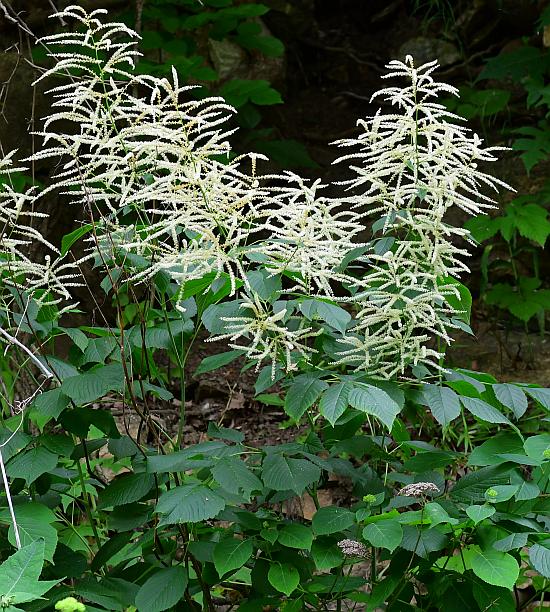Aruncus dioicus (Walter) Fernald
Goat's Beard

Native
CC = 6
CW = 3
MOC = 46
© SRTurner
Aruncus dioicus (Walter) FernaldGoat's Beard | |
 |
Native CC = 6 CW = 3 MOC = 46 |
© SRTurner |
|
Family - Rosaceae Habit - Perennial forbs, dioecious, often incompletely so, with short thick woody rhizomes. Stems - Ascending or arching, unarmed, glabrous or sparsely hairy toward the tip. Leaves - Alternate and basal, mostly long-petiolate, at least the lowermost petioles somewhat expanded at the base and partially sheathing the stem, the sheaths extended downward along the stem as fine longitudinal ridges. Stipules absent. Leaf blades 5-50 cm long, ovate to ovate-triangular in outline, 2-3 times irregularly ternately or pinnately compound, the leaflets 2-15 cm long, ovate, elliptic, or oblong-elliptic, occasionally with a single deep lobe, long-tapered at the tip, rounded to shallowly cordate at the base, the margins sharply and doubly toothed, the upper surface glabrous, sometimes with sparse, minute, stalked, reddish purple glands along the midrib and main lateral veins, the undersurface sparsely to moderately pubescent with appressed, fine, curved hairs, especially along the veins.
Inflorescences - Terminal panicles with densely racemose branches, the axes pubescent with curved hairs, the flowers short-stalked, each subtended by a minute linear to narrowly triangular bract.
Flowers - Mostly unisexual, perigynous, the hypanthium saucer-shaped to shallowly cup-shaped, with a nectar disc around the margin, glabrous or sparsely hairy. Sepals 5, 3-6 mm long, ascending, triangular, glabrous, white to cream-colored in staminate flowers, green and often with thinner pale margins in pistillate flowers, persistent at fruiting. Petals 5, 0.7-1.0 mm long, obovate to elliptic-obovate, white. Stamens about 20, highly reduced in pistillate flowers, the anthers yellow. Pistils 2 or 3, highly reduced in staminate flowers. Ovary superior, glabrous, with 1 locule and 2-4 ovules. Style 1 per pistil, persistent and forming a slender beak at fruiting, the stigma capitate.
Fruits - Follicles dehiscing longitudinally along the inner surface, pendent at maturity, 1.7-2.2 mm long, narrowly oblong to narrowly bean-shaped in outline, glabrous, shiny, brown at maturity, with 2-4 seeds. Seeds 1.5-2.0 mm long, linear to narrowly oblong in outline, 2- or 3-angled and usually narrowly ribbed, the ribs extended as small wings at each end, brown.
Flowering - May - July. Habitat - Bluffs, wooded slopes, rocky and moist woodlands, ravines. Origin - Native to the U.S. Other info. - In Missouri this attractive species can be found predominantly in the southern half of the state. Its U.S. distribution is mostly limited to Missouri, Arkansas, and Illinois. It is typically an indicator of high-quality, relatively undisturbed areas. The plant is easy to identify because of its big sprays of whitish flowers that quickly become tan when drying. The large, compound leaves are also diagnostic. The plant (especially staminate individuals) can be quite showy, though the flowers do not last long. It does well in gardens and is deserving of more widespread cultivation. Missouri material is referable to var. pubescens (Rydb.) Fernald, though infraspecific forms are often not well differentiated. Photographs taken in the Ozark Scenic Riverways, Shannon County, MO., 6-11-04 (DETenaglia); also at Weldon Spring Conservation Area, St. Charles County, MO, 6-15-2011 and 5-23-2012; Don Robinson State Park, Jefferson County, MO, 5-24-2017; in Lincoln County, MO, 8-8-2018, and near Labadie, Franklin County, MO, 5-25-2021 (SRTurner). |